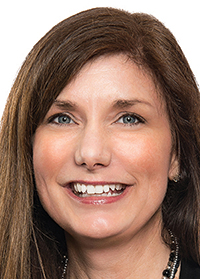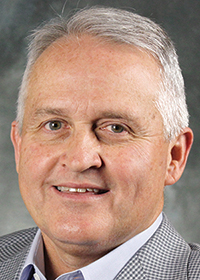Banks strategically manage in-person, digital offerings
by April 26, 2021 11:51 am 1,201 views

The COVID-19 pandemic accelerated the shift in customer banking preferences and increased digital banking offerings, bank executives said. Meanwhile, U.S. banks closed a record number of branches in 2020. Still, some area bank executives plan to open new branches and banking centers.
U.S. banks closed a record 3,324 branches in 2020, according to S&P Global Market Intelligence data, which didn’t include temporary bank closures like those caused by the pandemic. And they opened 1,040 branches last year.
However, according to S&P Global, banks continue to announce plans to close branches as customers seek more virtual banking options because of the pandemic and increase mobile technology use. Wells Fargo & Co. announced 250 branch closures for 2021. Truist Financial Corp. planned to close 226 branches in the first quarter.
“2021 is the year of branch closures,” said Christopher Marinac, director of research at Janney Montgomery Scott LLC. “We just simply had a very clear appetizer in 2020. Banks realized that they had to evolve. The pandemic just simply put this on warp speed because instead of taking five years to play out, it’s going to take probably two years.”
Fayetteville-chartered Arvest Bank recently announced plans to close almost 12%, or 31, of its more than 270 branches as part of a branch transformation strategy.
“The past year has introduced many challenges to the banking industry and accelerated existing trends in consumer preferences and behavior,” according to a bank statement. “Most significant for Arvest Bank has been a shift in the balance between branch transactions and digital banking. In response to these significant changes in customer banking preferences, Arvest has conducted an in-depth analysis and will make changes to its branch network in 2021.”
The strategy also included plans to build eight new facilities and 15 remodeling projects over the next 12-18 months. It plans to add 38 ATMs with Live Teller, allowing customers to have face-to-face communication with tellers via a video screen.
BANKER CONNECT
Angie Garrett, executive director of digital innovation and data science for Arvest Bank, said the branch reconfiguration process allows the bank to look at the branch network more strategically.

“In light of the changing customer preferences and how we use branches, it can ensure us we’re delivering that branch network that best fits our customer needs,” said Garrett, who leads the bank’s Experience Lab, or EXP Lab. “At EXP, one of our missions is to focus on customer experience, whether digital or physical. We will always be involved when it comes to optimizing that customer experience.”
The Arvest Banker Connect app has been transitioning from the testing phase. The mobile app, which is available for Apple and Android devices, was developed through a partnership with San Francisco-based fintech Agent IQ.
Arvest Bank’s Arvest Go mobile banking app is separate from the Banker Connect mobile app, which has been transitioning from the testing phase. The bank has yet to determine whether to integrate the two apps.
Customers with online banking access can use Banker Connect to conduct business and ask questions to a banker of choice. When they sign up, customers select a banker with whom they would like to communicate and do business.
“What makes this nice and interesting, we think, is … that banker in Banker Connect gets to know the customer because they stay connected with them,” she said. “So, over time, I get to know you a lot better, and I can better serve you.”
It’s unique from live chat, she noted. For example, customers can message questions after-hours when their banker isn’t online. “It’s peace of mind,” she added. “It’s meant to get it off my to-do list and onto somebody else’s to-do list.”
CHANGES ACCELERATE
Asked about the future of bank branches and the balance between planning for branch and digital offerings, he said he expects a decline in overall branch construction, and those that are built will look different. They’ll look more like drive-thru coffee shops, such as 7 Brew, he added. And they’ll have less staff and more ATM or ITM technology, the latter of which allows customers to complete teller transactions via video conferencing.

On Feb. 1, Generations Bank opened a new location in Bentonville. The bank has 10 branches and does not have plans to add more. However, Harrell expects continued growth with its existing branches coupled with investments in technology to meet customer demand.
GROWING FOOTPRINT
Some banks look to expand their footprint in Northwest Arkansas. Springdale-based United Bank plans to open a branch in Bentonville. First National Bank of NWA, a division of First National Bank of Fort Smith, intends to add banking centers over the next five to 10 years.
“We still see value in having brick-and-mortar, but I don’t think it’s a need to have brick-and-mortar everywhere,” said Rob Husong, president of First National Bank of NWA. “We need to have some key locations. Customers like knowing they can go to the bank. They like knowing where their lender sits, or their officer sits, or their account person sits. So if they ever have a problem, they know they can go across town or wherever it may be.”
The bank has six branches in Benton and Washington counties and recently reopened the lobbies. While customers like digital offerings, he said a lot of them still want interaction with people.
“It’s amazing how much banks fulfill that role for some people, especially community banks,” Husong added. “We get to know our customers. We get to see their faces every day. That’s meaningful to them more than the digital channel to conduct business. That person means something to them.”

Nathan Gairhan, president and CEO of United Bank, said its lobbies have reopened except for the Rogers location, which is being updated. The bank has four locations. Construction is to start this year on a fifth location, and he said it’s expected to open next year as part of a 12,000-square-foot office and retail building at Arkansas Highway 102 and Been Road.
“We feel like we need the physical branches,” Gairhan said. “The pandemic has certainly changed the way banks communicate with customers, but for a relationship-focused community bank, which is what we consider ourselves, the branches are going to continue to be very vital for our business. Over time we’ll continue to expand and add some additional locations.”
Amid the pandemic, the bank has handled many online account openings, and account numbers have risen, he said. Also, the mortgage department has been busy taking home loan applications, which can be completed online. And it added a position dedicated to handling digital inquiries via email or chat and new account requests.
“As a community banker, [we’ve tried to] take a top-floor approach as to how we do business today, what’s it going to look like in the future and trying to synchronize our retail delivery strategy and investment of both digital means as well as physical banking locations,” Gairhan said.
